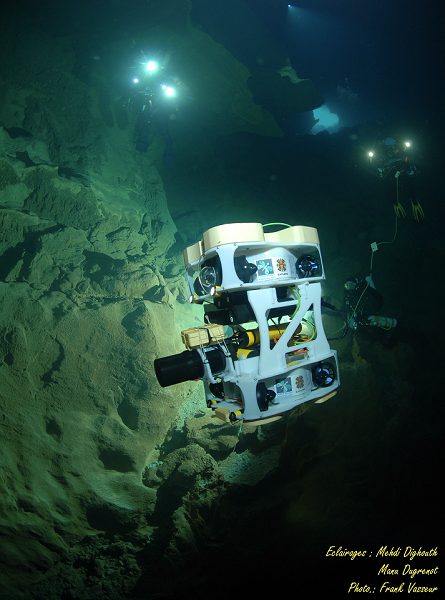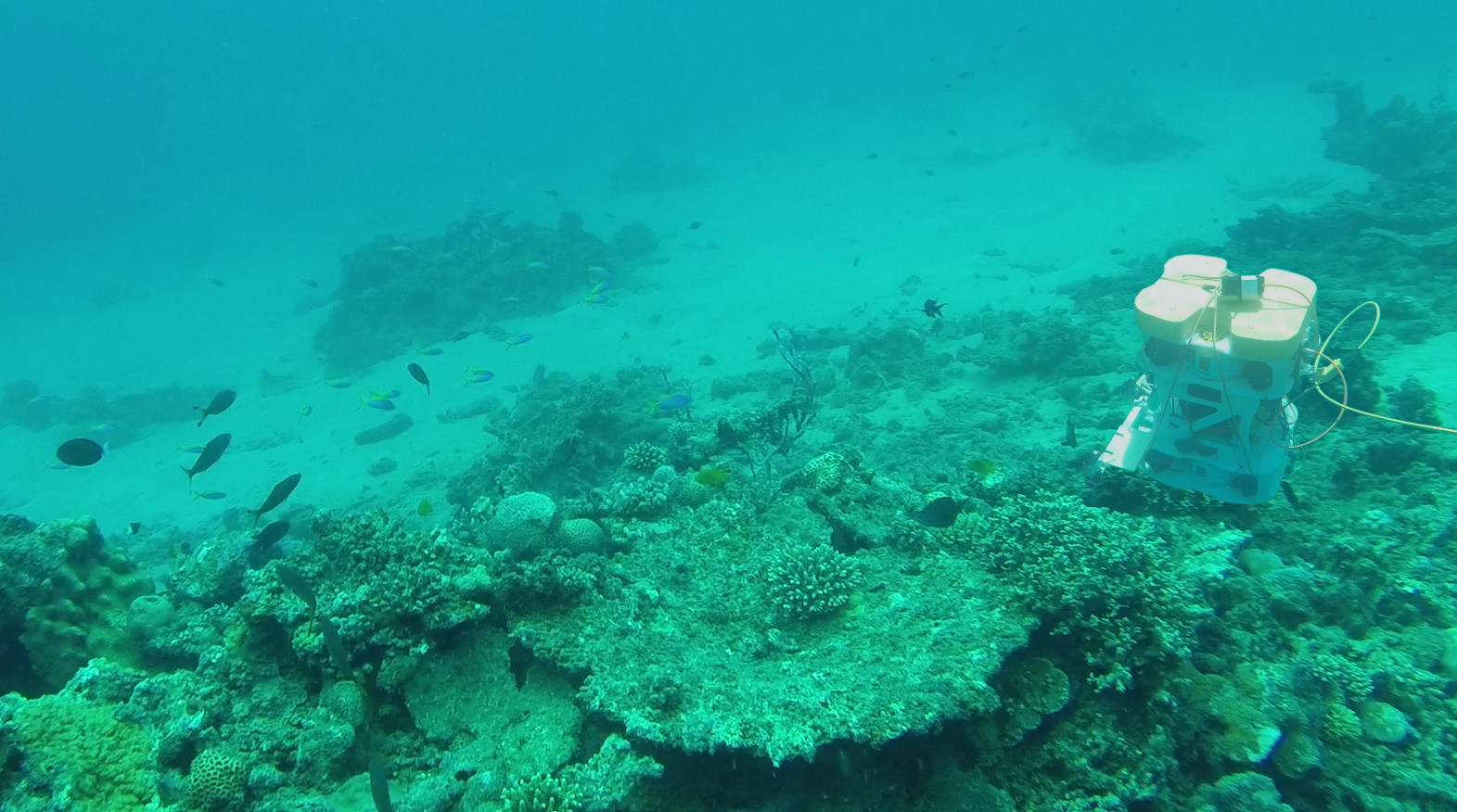MAIN APPLICATION DOMAINS(see the Applicative projects page) |
|
|---|---|
Kartic networks exploration | Marine biodiversity assessment |
 |  |
TRANSVERSAL RESEARCH THEMATICS |
|---|
|
Design, modeling and command of underwater robot
Our main thematic is the modeling and dynamic control of overactuated, underactuated and adaptively actuated mobile systems in aquatic environments. The design of the control laws is based on non-linear approaches such as Lyapunov and exact linearization on Riemannian varieties (in particular the quaternionic hypersphere) or, more recently, in se (3) algebra. The issue of robustness is explicitly addressed. The convergence guarantees provided by these design techniques are then exploited to address the issue of the search for performance guarantees applied to the whole robotic system.
These control laws are applied to the following four problems, taken separately or in combination:
- stabilisation;
- path following;
- trajectory or target following;
- obstacle avoidance.
These control (or guidance) laws are implemented in an architecture of the Navigation-Guidance-Control (NGC) type. Navigation deals with observation, estimation and thus localization and mapping (SLAM) of the robot. These approaches are applied to the specific contexts of our application goals (confined environments – Karst, navigation related to the environment – coral reefs). These contexts require to draw up environment models adapted to their implementation and exploitation in the control loop.
Another of our themes deals with the properties of the actuation. It is approached by an algebraic optimization approach of the structural redundancy of the actuator and by taking into account non-linearities (saturations, dead zones and differentiable non-linearities) of the actuator response. This work aims to :
- ensure the robustness (fault tolerance) of the actuating stage,
- adapt the performance of the actuation stage to the different contexts of the mission (energy optimisation, reactivity, reachability, etc.).,
- adapting the control to systems with a variable actuation structure, up to stable switching between different actuation configurations (e.g. over- and under-actuated).
Dependability and garantee of performance
A first step in the dependability of a system is to improve the confidence that can be placed in the robotic system by using high-level decision behaviour validation methods. By representing this behaviour as a discrete-event system, it is then possible to use formal methods such as model-checking to exhaustively verify some of the expected properties of the system (such as the feasibility of a robotic mission).
Reliability is an essential property of autonomous systems. It requires the implementation of fault tolerance and FDIR (Fault Detection Isolation and Recovery) techniques. The control architecture must continuously monitor the system’s behavior to detect the occurrence of software or hardware faults in order to adapt the NGC sequence according to the operational resources. This requires a prior analysis of the system to identify potential failures, their origins and, depending on their severity, the corrective actions that can be executed.
We are also interested in the possibility of guaranteeing the performance of a mission, both before and during its execution. The proposed methodology is based on the projection of performance constraints (mission duration, energy consumption, location accuracy, etc.) on the nominal scenario of the mission. In a known environment, we addressed the problem of the system’s behavioural autonomy by allowing deterministic offline and online management of hardware and software resources ensuring the satisfaction of performance objectives imposed by the user.
Representation of the environment
The particularity of the applicative ambitions of our work is that the system moves or acts in reference to the environment, whether it is confined in the case of karst, or ‘semi-open’ for navigation near coral reefs. Thus, the control of these robots must be carried out in relation to a model of the environment. The latter is necessarily a fusion of the a priori knowledge (if available) with the knowledge acquired from the environmental sensors available on the robot. These models are then used to perform confined karstic navigation (centering and detection of navigable space, SLAM) and obstacle avoidance or bottom and/or wall tracking for coral navigation. Thus the question of environmental representation is a key issue in our work.
Our works related to the representation of the environment have been deployed through an action directly linked to the underwater domain and a more upstream study on the semantics that can be associated with models of the environment.
ARCHEO: the aim of this project is to reconstruct in 3D archaeological objects in a submarine environment. A fusion method is proposed in order to obtain a 3D map from sonar data and the underwater stereovision system. In a first step, the reconstruction of 3D objects is carried out from a system using a pair of stereoscopic cameras. The second step uses 3D data of the underwater environment from a multibeam sonar. Then, optical and acoustic data are mapped, requiring the different resolutions of these two sensors to be taken into account.
SEM (Semantic Environment Modelling): the objective of this project is to explore and use new modalities in the creation and use of environment maps. The environment models used in robotics are generally based on very low-level primitives, mostly geometric. These primitives are very useful for navigation and gripping tasks, but they are very limited when describing a mission or involving human expertise. Semantic information, when it is present, is thus generally under-exploited and confined to classification activities according to a pre-existing ontology. Our approach is based on the creation of ontologies on the fly, using visual information and knowledge bases available online. The objective is to allow the creation of structured models without initial data: by exchanging information with the human user.
